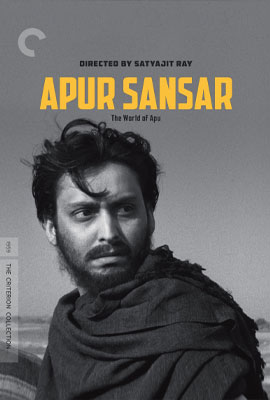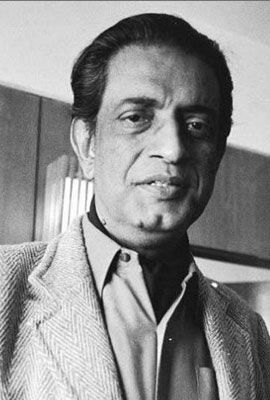
(1959)
directed by Satyagit Ray
This sublime film concludes Satyagit Ray’s Apu trilogy. “Apur Sansar” means “The World of Apu.” Ray is at the height of his powers in this film. I watched “Apu Sansar” for the first time in preparation for writing this chapter. It is one of the most beautiful, uplifting, and emotionally wrenching movies I have ever seen. For several days after watching this movie, every time I recalled Apu and Aparna’s touching love for one another, I would get tears in my eyes. “Apur Sansar” is the perfect conclusion to one of the greatest film trilogies of all time. It is my favorite of the three movies.
“Apur Sansar” is divided into three parts. In the first part, we find the adult Apu living in Calcutta and working as a struggling writer. He earns a meager living by tutoring students. He is alone in the world having lost his sister in “Pather Panchali” and his father and mother in “Aparajito.” The film opens with Apu lying in bed asleep amid scattered papers and an overturned bottle of ink. A tattered curtain is soaked by rain and flutters into the room. He is three months behind on his rent and is forced to sell some of his precious books to pay his rent.
Pulu, an old friend, drops by for a visit. He invites Apu to a wedding at the country estate of a wealthy family in the village of Khulna. Apu agrees to attend the wedding with Pulu. They travel to the wedding on a primitive river boat. As they travel along the river, the scenery is dreamlike and very beautiful. When they arrive at the country estate, the bride’s mother is very impressed with Apu. She can see that he is handsome and well educated. She tells everyone he looks like the god Shiva. On the day of the wedding, the groom is clearly mentally ill. The bride’s mother refuses to allow the wedding to take place. She says that, if necessary, she will kill herself to prevent the wedding from taking place. We feel how deeply the mother loves her daughter.
The young bride, Aparna, is left alone and unmarried. Her superstitious family believes that if her wedding does not take place at the appointed hour, she will be cursed forever. Pulu asks Apu if he would be willing to marry Aparna and save the day. At first he resists. He says the idea is “crazy” and is based on ignorance and superstition. There is magic in the air, however, and Apu miraculously agrees to marry Aparna. As I watched this scene, I imagined thousands of Indian grandmothers breathing a sigh of relief! Based on my own matrimonial missteps, I suppose a marriage based on magic and omens is as likely to succeed as any other!
Apu and Aparna have a magical chemistry from their first moments together. Sharmila Tagore, who plays Aparna, was only fourteen when she made the film. She radiates exquisite shyness and tenderness. There is a wedding night scene that takes place in an elaborately decorated bedroom. Aparna stands shyly on one side of the bed. Apu paces back and forth on the other side of the bed. They are separated by an enormous pile of expensive fabrics and beads tossed across the bed. Apu asks, “Can you live with me in poverty?” Aparna smiles shyly and answers, “Yes.”
It creates quite a stir in the neighborhood when Apu returns unexpectedly married with an incredibly beautiful bride by his side. Aparna is dressed in her traditional wedding attire. The news travels fast and before long a crowd has gathered to see the bride. All the mothers and grandmothers are beside themselves when they see the young bride. This scene is one of my favorites.
The second part of the movie is exquisitely joyful and romantic. It shows how Apu and Aparna come together as strangers and then grow to understand and love one another. With just a few deft touches, Ray shows us what it means to fall in love. Aparna replaces the tattered curtain in Apu’s apartment with a beautiful new curtain. Soon Apu’s dismal bachelor pad is welcoming and homey.
There is a wonderful scene where Apu awakens and finds a hairpin between the pillows. He watches his wife as she tidies their room. When he tries to light a cigarette, he finds her note inside his cigarette pack reminding him that he promised to smoke only one cigarette after each meal. Later, the couple exchange a series of playful letters while Aparna has returned to her parents’ home to give birth. One can sense Apu’s delight while reading his wife’s letters. I have never seen a couple’s love portrayed so touchingly as it is in this film.
The third part of the film reveals a terrible tragedy and its aftermath. Aparna dies giving birth to a son and an utterly devastated Apu abandons his child for the desolate life of a wanderer. In the final scene of this extraordinary movie, however, Apu is offered an opportunity for redemption. The Apu trilogy is filled with tragedy but there is always a ray of hope for the future. The Apu trilogy is a sublime work of art that reflects how difficult human lives have typically been through most of human history.
Satyagit Ray

Satyagit Ray, the director of “Pather Panchali,” started his career as a commercial artist. He was drawn into film making after meeting the French director Jean Renoir and after seeing Vittorio De Siva’s Italian neorealist film “Bicycle Thieves” during a visit to London.
When Ray started filming his movie “Pather Panchali,” he had never directed a single scene, his cinematographer had never filmed a single scene, and his child actors had never acted. Despite all this inexperience, early footage was so compelling it helped Ray obtain financing for the rest of his movie.
Inexperience may have actually fostered creativity. At the time, movie crews waited for good weather and shut down production if it was raining. Ray followed his instincts and solved problems like how to film in the midst of a rain storm with umbrellas, tarps, and a “must do” attitude.
Ray was the first Indian to receive the Academy Honorary Award for his tremendous impact on film making. Ray was the second film personality after Charlie Chaplin to be awarded an honorary doctorate degree by Oxford University. Ray also received numerous other awards and honors including the Commander of the National Order of the Legion of Honour, the highest decoration in France.
Ray’s genius was matched by his humility. According to the leading actor Babita, “One of the most remarkable experiences working with Satyagit Ray was when one day, while shooting, I had to cross a small bridge on foot. I had to take my slippers off and forgot to pick them up. When I turned around, I was shocked to see that Mr. Ray was carrying my slippers! This was a lesson in humility that I’ll never forget.”
Ray was a hands on director. His script writing and directing were accompanied by his meticulous set and costume designs. He designed the calligraphy for the opening credits, selected the cinematography, composed the music (sometimes in collaboration with composers like Ravi Shankar), and designed the posters for his film releases.
Satyagit Ray was a director of breathtaking talent and breadth. Ray took the earth, the sky, the rivers, and the clouds, introduced his simple, heartwarming stories, and fashioned his characters from the ordinary people of his beautiful country.